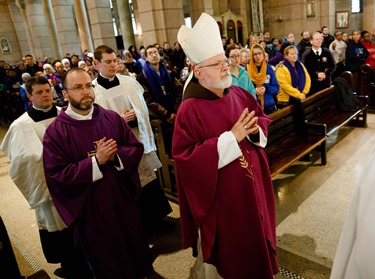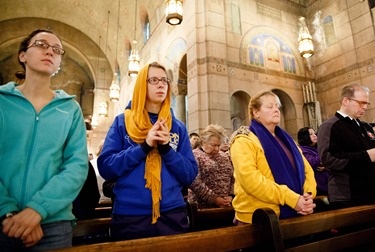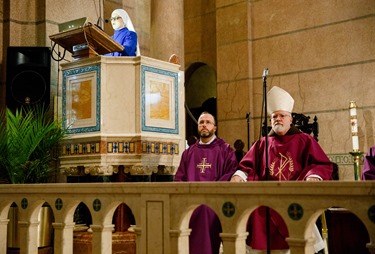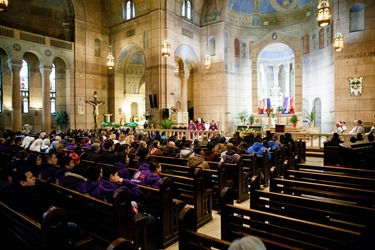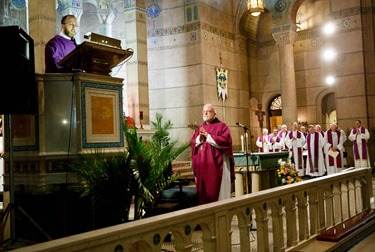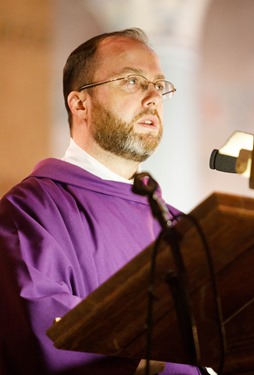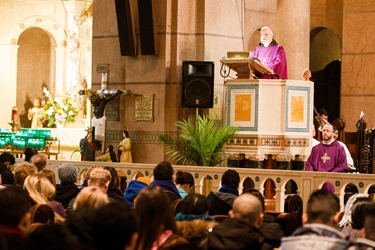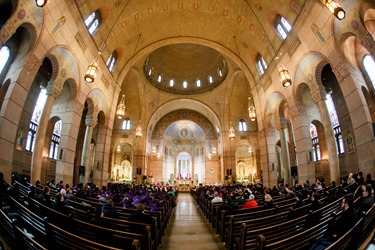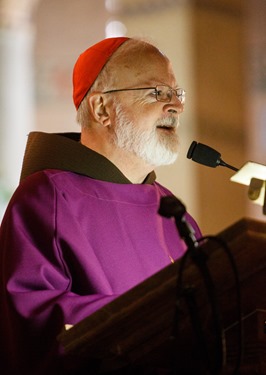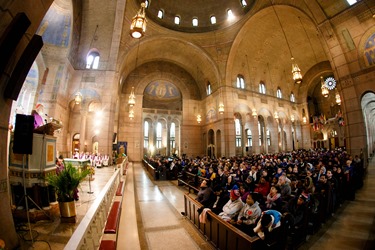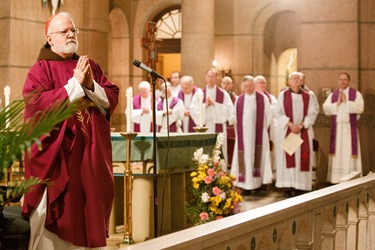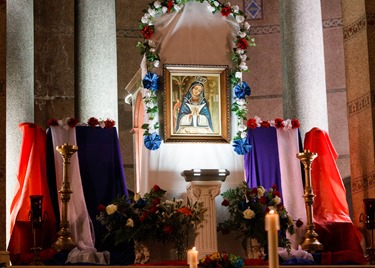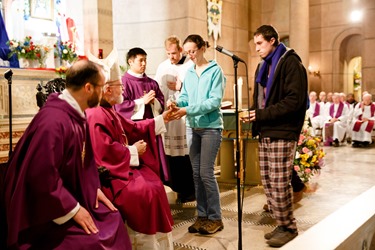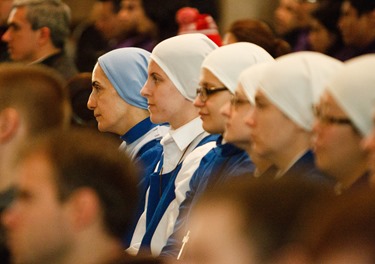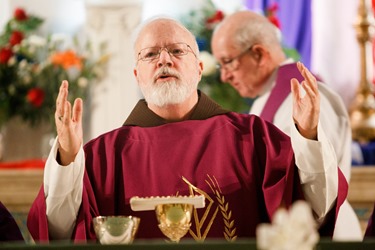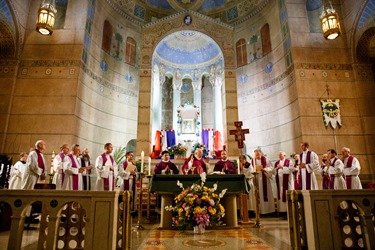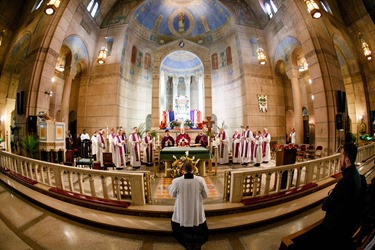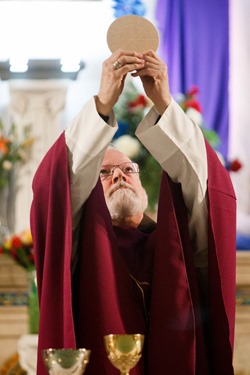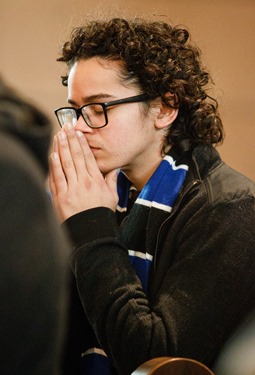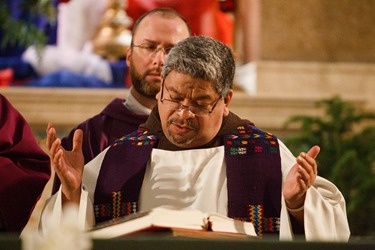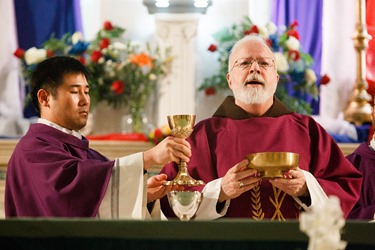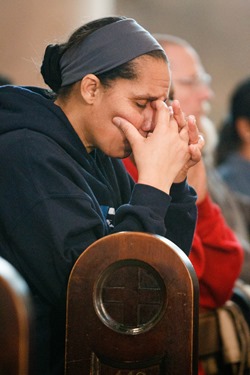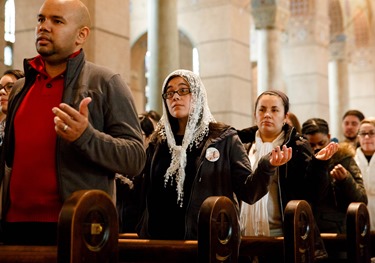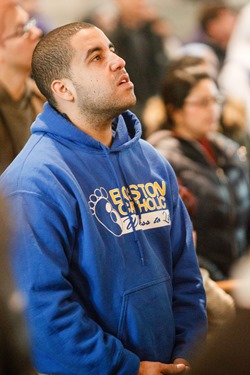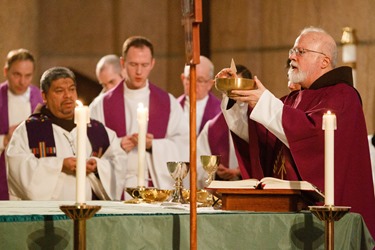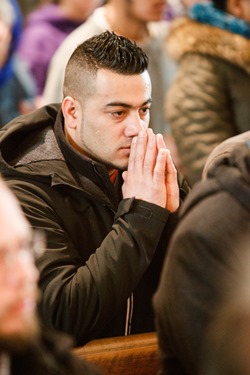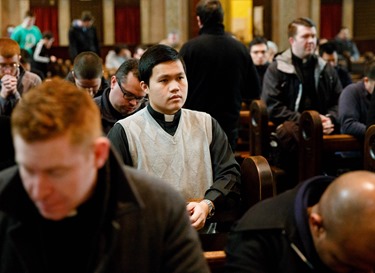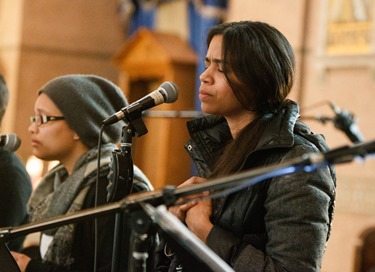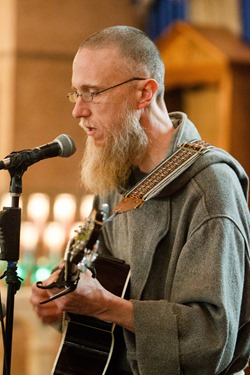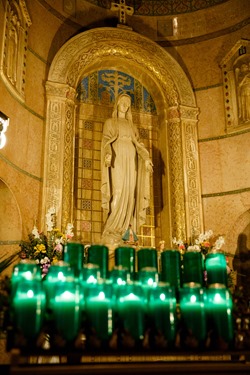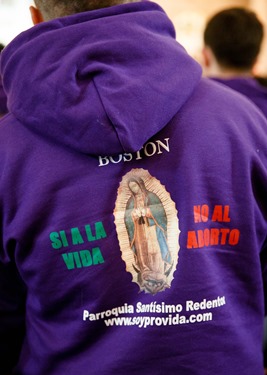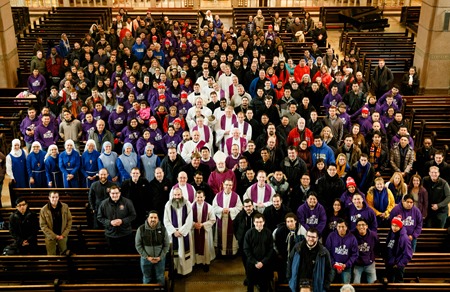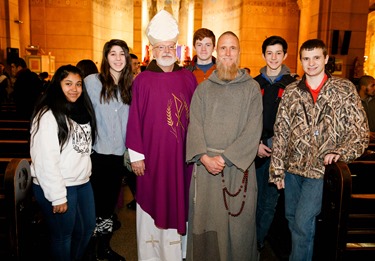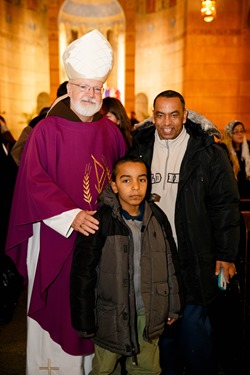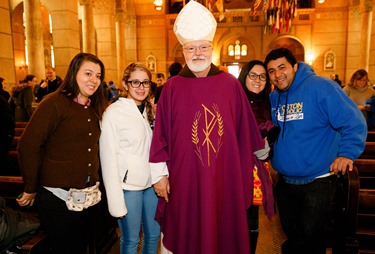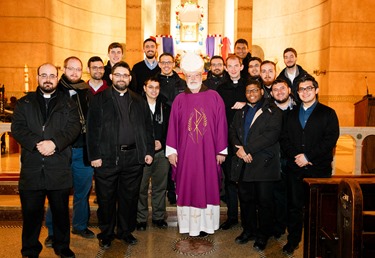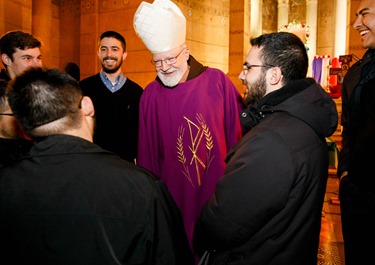Hello and welcome!
As I left off last week, we were about to take part in the March for Life.
Although, because of the snowstorm, the Witness to Life Pilgrimage led by Father Matt Williams had to cancel their trip for many of our young people, I was very gratified that we still had many busloads of people able to come to the March for Life as well as our seminarians from St. John’s Seminary and Redemptoris Mater Seminary.
As I always do, I gathered with those from Boston in the morning before the March. There were about 500 people there with us at Sacred Heart, a parish where I had worked as a priest and is now in the care of the Capuchin Friars.
Because there were so many Hispanic people who had come from Boston we celebrated the Mass bilingually.
I’d like to share my homily with you here:
– – –
Following the Mass, we went down to the National Mall to join in the March for Life.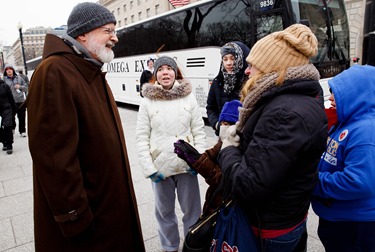
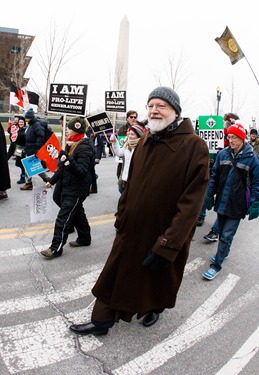
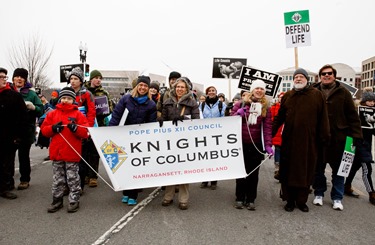
Despite the threat of the weather – because the snow didn’t really start until the March was already underway – there was a very good crowd.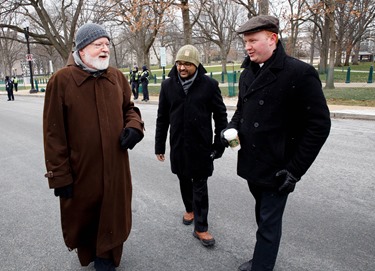
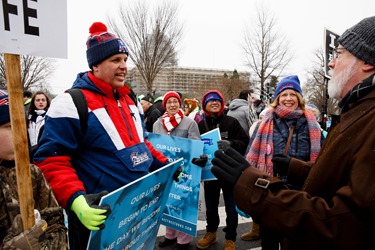
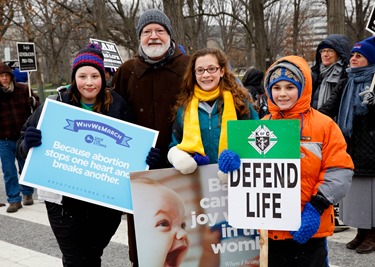
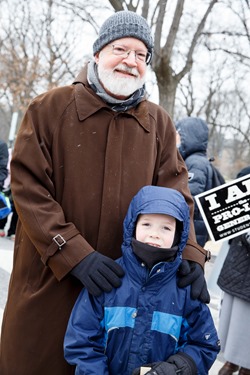
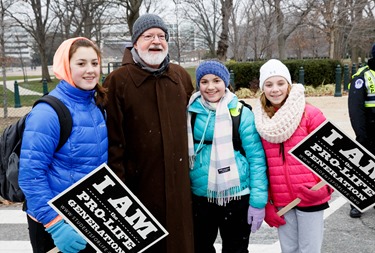
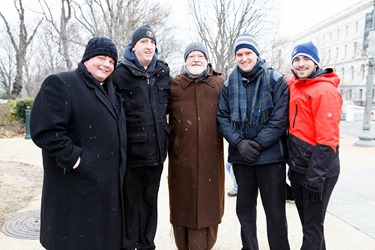
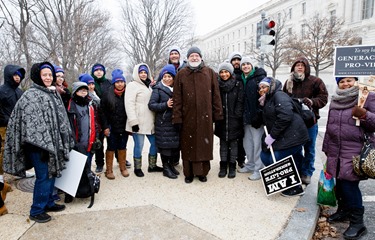
I think that the witness and the testimony of the March for Life is always stronger when people see how many thousands of people turn out, despite difficulties and challenges of weather. 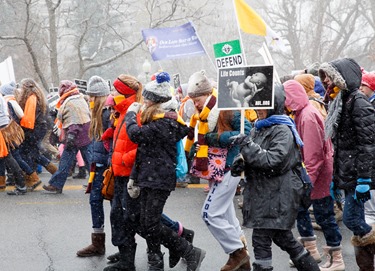
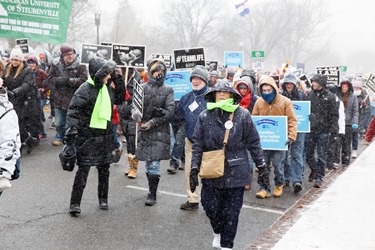
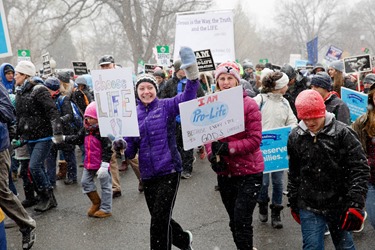
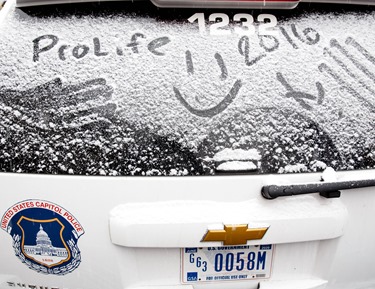
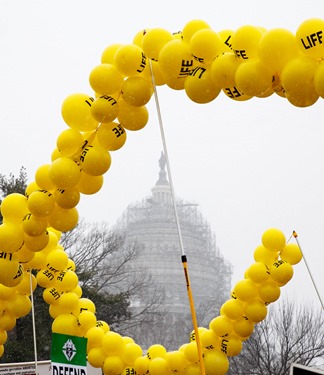
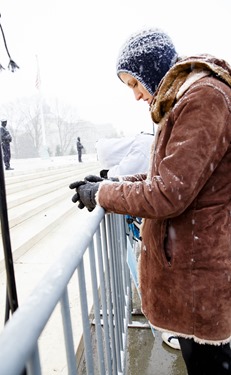
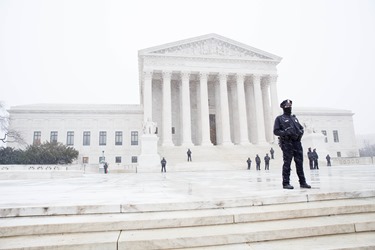
It was also good to see how many Orthodox were present at the March this year. With us this this year as well were a number of Protestants, particularly the Lutherans were strongly represented. It’s always good to see how many different faith groups take part in the March for Life.
I was also very happy to see the group led by a priest from France who had come to the March. I had had a chance to meet him at the Opening Mass of the Prayer Vigil for Life at the Basilica of the National Shrine of the Immaculate Conception the evening before.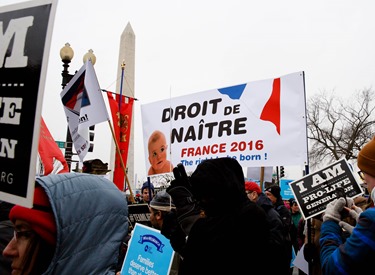
This is a phenomenon that we’ve seen before, that people come from other countries to experience the March for Life and then take it back to their own native countries. So, this just goes to show the multiplier effect that this wonderful event has had throughout the world.
– – –
While many from Boston were unable make it to the March, I was pleased that a large number of young people and students were able to gather at the Cathedral of the Holy Cross. They gathered at the cathedral about mid-day and made their own Boston March for Life to the State House.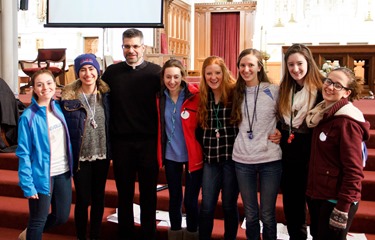
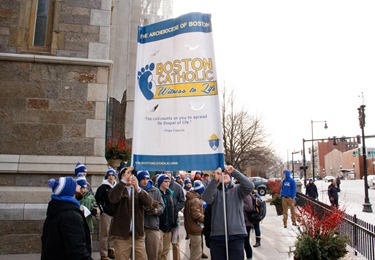
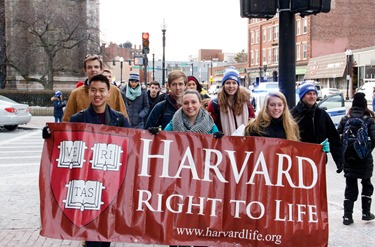
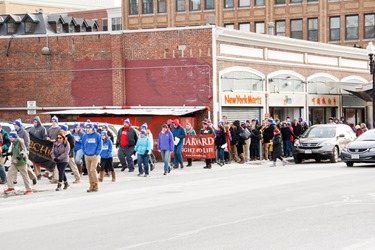
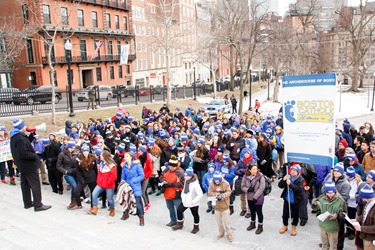
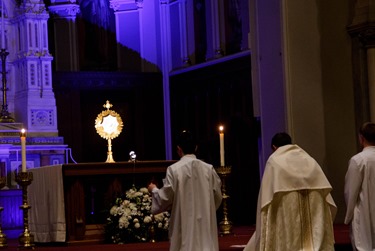
Since I was unable to be with them, I sent them this video message:
I am very grateful to Father Matt Williams and the many others who worked with him in the herculean effort to organize this gathering on such short notice so that our young people would be able to be with us in prayer as we marked the important anniversary of Roe vs. Wade.
– – –
Though we did manage to make it through the March for Life without too much snow, that didn’t prevent me from being snowed in with the rest of the people in Washington afterwards. 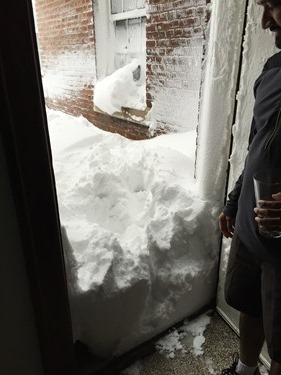
We received nearly 3 feet by the time the storm ended, and for Washington that’s just a phenomenal amount of snow.
As I often say, Washington is a city that is paralyzed when there is even a rumor of snow. It doesn’t even take one flake to have things start shutting down. So, 3 feet was really very debilitating and a lot of people were stranded in the city for the weekend.
However, I was blessed to be at the Capuchin monastery with the Friars. It’s like a retreat for me to be able to be with the Friars, pray with them and experience their fraternity.
It’s a wonderful community and I always enjoy being with them, so this was a blessing that came out of the snowstorm for me.
– – –
By Monday morning we were dug out and I was able to take my flight in time to get to St. Vincent de Paul Seminary in Boynton Beach, Florida, in my former diocese of Palm Beach. There, I celebrated the Mass with a number of bishops, priests and friends in the seminary to mark the 50th anniversary of the dedication of their chapel.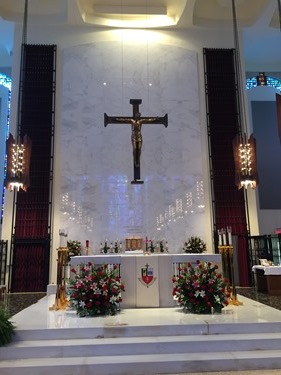
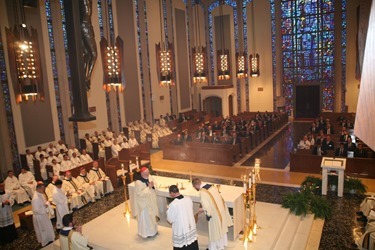
Following the Mass, I joined them for the dinner they held for priest alumni and friends of the seminary. 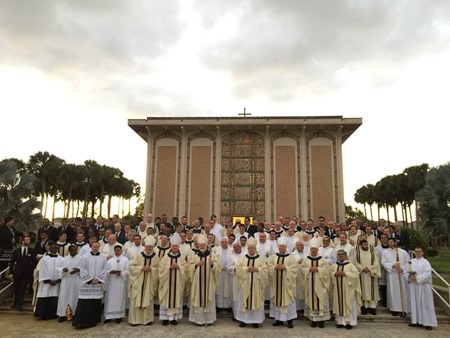
I also gave the keynote address that evening on the joys and the challenges of the priesthood, which I would like to share with you here:
“Taken from among men for the things of God”
Joys and challenges in the ministry of the diocesan priest
Once I was visited by a priest who was very discouraged. He said: “Bishop, I am the worst priest in the world.” I said to him, that is quite a distinction. I asked him about his ordination and first Mass. I said, “Did you fight over who was going to be first in line at your ordination? Did you betray Christ for a handful of money? Did you chop off someone’s ears with a machete? Did you then run away and hide?” I was of course comparing the ‘worst priest in the world’ with the first priests of the world, the apostles.
The vocation of the apostles begins with the joyful discovery of Christ, and with the reckless abandoning of their boats, their nets and their families, to follow the Lord. It wasn’t too long however, when they were soon in competition with each other and worried about their retirement benefits, like who was going to have the thrones of the right and the left.
To me one of the most poignant scenes in the Gospels is the apparition of the Risen Christ on Easter to the eleven remaining apostles. They’re hiding out in the Cenacle with the doors bolted. Suddenly, Christ is in their midst showing them his wounded hands as if to say: “See how much I love you.” The reaction of the apostles certainly must have been one of very conflicted emotions. First of all, they were overjoyed to see that Jesus was alive and in their midst. Secondly, they would have felt a profound shame and embarrassment because of their cowardly behavior. The apostles did not surface even to bury Jesus’ body after the crucifixion. Had it not been for Nicodemus and Joseph of Arimathea, Jesus’ body would have been cast into a common ditch to be savaged by vultures and dogs. But Jesus’ love and forgiveness is so great, He does not even remind them of how badly they have behaved, but instead gives them the gift of the Spirit so that these sinners could become wounded healers.
I find immense consolation in the fact that the Gospels give us, not pious platitudes, but a gritty, realistic portrayal of our first priests, the apostles. They were ordinary men like ourselves, full of humanity and shortcomings and idiosyncrasies. They were entrusted however, to carry on the most important mission in the history of the world and despite all of their weaknesses, they did an extraordinary job.
I’m sure that all priests at one point have felt a certain envy of the apostles. We imagine how wonderful it would be to be there and hear Jesus’ voice, to see his miracles, to experience the closeness, the companionship and joy of being in his presence. It is ironic, however, that the apostles’ worst behavior came about while Jesus was still with them. It was only after the Pentecost experience that they go out boldly to proclaim the gospel and to share with the world what they have received.
The theme of this talk, “Taken from among men for the things of God,” comes from the third paragraph of Presbyterorum Ordinis. Like the Apostles, priests today are ordinary men called by God and formed for service to his people.
As a diocesan bishop, I meet regularly with priests who have been ordained for five or fewer years. We pray, spending an hour in Eucharistic Adoration, share a meal and talk about their joys and challenges in their ministry. Because they are seeing the priesthood through fresh eyes, these young priests articulate powerfully so many of the high and low moments that all priests experience.
Last month, I had the opportunity to ask this group of twenty-seven recently ordained priests to write down their top joys and challenges of priestly ministry. Since these priests entered priestly formation within the last ten years, their responses are a good measure of whether the goals of Optatium Totus, Presbyterorum Ordinis, and later Pastores Dabo Vobis have been realized in the formation and life of priests today.
While this group is just one cohort of priests from one archdiocese in the United States, they captured the joys and challenges that I’ve been hearing from priests throughout my service as a priest and bishop.
Joys
The top two joys expressed by these young priests were ministering the sacraments of healing: Reconciliation and Anointing of the Sick.
One priest wrote that hearing confessions “was something that I was worried about doing before my ordination but it has turned out to be an incredible joy to be able to bring God’s healing and forgiveness to people of every type of situation, from children receiving their first penance, to people returning to the sacrament after decades away from it.” Another shared that he “had several people who came to confession with destroyed lives (due to sins like abortion or drugs) and [he] saw first-hand how, by the time they left the confessional, their voices changed. God had forgiven them!” A third priest submitted that for him “the ministry of mercy in the confessional is a great joy. I wish that there were ten times the demand for it!”
Pastoral care of the sick and dying is also one of their top joys. From visiting the ill and infirm, to administering the Sacrament of Anointing of the Sick, to praying with a family at a wake, to celebrating a funeral Mass and committal, these young priests cherish bringing the love of Christ and the Church community to those at the end of life. One priest noted that it is a joy to “give hope for those in their deathbed and for their loved ones. Once I entered the hospital room of a woman who was very much afraid of death. She was told that she was going to die and there was nothing else to be done. Yet after she received the anointing of the sick and the forgiveness of her sins and the viaticum, her face was lightened up and she was happy, willing to die, and ‘go home!’”
Another young priest commented that, “In seminary, I did not consider profoundly the Sacrament of the Sick, but now I know it to be a singular and intimate moment of encounter, grace, mercy and peace. I have been fortunate to experience many sick calls and I love going. On one occasion, I passed by a room filled with people. (It was later in the day than my usual visit due to laziness on my part). As I walked in, one of his 8 children said, ‘Father, you are not going to believe this: Our father is dying and he went to Mass every day. My sister just said how she wished a priest could be here, then we looked up and saw you.’ I gave him Viaticum, we prayed and then sang. 40 minutes later he died. I was amazed at God’s faithfulness and how he used me (even through my laziness) to be with His son. God showed this man and his family that the promise made 88 years before at Baptism to be with him always is still true!”
It is no surprise that Celebrating the Eucharist and Preaching about the Scriptures have been highlights of these priests’ first years of ministry. In recent studies of priestly satisfaction in the United States, 95 percent of priests say that celebrating Mass is a great joy and 80 percent treasure preaching about the Word. The Eucharist is the high point of a priest’s daily life and our recently ordained priests experience it as a daily renewal and strengthening of their priestly identity.
Once after Mass many years ago, I was greeting parishioners as they left the Church. One father carrying a small child asked the little boy as he pointed to me. Do you know who that is? Sometimes children say: God, the Pope, Santa Claus, but without missing a beat, the kid says, “He’s the communion guy.” I like that. Ex ore infantium. A priest is the communion guy. Saint John Paul II in Pastores Dabo Vobis speaks of the priest as a “man of communion”, “the communion guy.” It is a marvelous insight into the identity of the priest. Being men of communion begins with our attachment to Christ, the High Priest, the Good Shepherd, the Bridegroom. The Spirit that anointed Him and that descended on the Apostles at Pentecost has also anointed priests at their ordination. We must know that the Spirit is guiding the Church and is acting in our ministry. It is a joy to be “men of communion” and not private practitioners or “lone rangers” as we say in the United States.
These 27 priests of the Archdiocese of Boston also indicate that their work of preparing couples for the sacrament of marriage and preparing families for the sacrament of baptism of their newborn babies are sources of joy. Priests either witness the great faith of couples and families in these moments or can use the opportunity to reintroduce God’s love into the daily fabric of family life. One priest mentioned recently working with a couple that wanted to postpone their wedding due to financial reasons. Throughout the course of their conversations, the priest was able to encourage them to reprioritize things and they ended up simplifying their wedding day and focusing on the sacrament and not the reception as the central element. “The ceremony was prayerful, joyful and worthy of the Lord, especially because it was simplified.” Another young priest highlighted how he helped six cohabitating couples to be married last year and to embrace their marriage as a sacrament. This priest was thankful to God to see the fruit of his work of evangelization.
Our young priests also experience joy in their daily opportunities to witness the power and grace of Jesus working in the lives of people, comparing it to “having a front-row seat at a sports game.” One observed that, “It is as if God tells me, ‘See how much I love this person.’ I sometimes leave my rectory with a heavy heart of tiredness, fears or complaints, but almost without exception, I come back full of joy. I truly see my priestly calling as a way of my sanctification.” Another commented that it is a joy each day to be an “instrument of grace, hope and comfort to many people” who seek out the love of God and His Church. A third added, that the “top joy in my life is accompanying a parish community. It is being with the people in their high points and low points and helping them discover, or rediscover, their relationship with God.”
These young priests also experience joy from teaching and sharing the faith with young people. One wrote that it is often challenging to hold the attention of students preparing for Confirmation but then after praying with them, “I marvel at how the Holy Spirit speaks through me to help those kids and how students will seek me out to convey appreciation for what they have learned.” Another stated that he recently worked with the youngest students. “A couple of weeks ago before Mass, I gathered all the children at the front of the Church to teach them how to genuflect and about the Lord’s real presence. Now it gives me great joy to see them genuflect before the tabernacle before going into their pews.” A third priest said that “getting to know my parishioners and students is a tremendous gift to me, as their presence and faith inspires and energizes me.”
Challenges
These 27 recently ordained priests, like over 90% of priests according to recent studies, are substantially happy and joyful. Nevertheless, they were able also to identify challenges that they deal with frequently in their ministry.
Generally, priests face many difficulties today: ministering in a time when the number of priests has declined and the average age has risen. Often people have high, even unrealistic expectations of priests. The consumer mentality by which priests are to provide quick, efficient and friendly service like people expect from salespersons or hotel clerks. In addition, priests must minister in a culture that is often unfriendly to a faith-centered perspective. Priests must be self-giving in an age of narcissism, of “me first,” and a culture of entitlement that makes people believe they deserve to be given what earlier generations assumed they had to work for. Priests must preach the Gospel in an age in which religious faith, Church authority, and institutional religion are questioned, doubted and even ridiculed. Priests must strive to lead a chaste life in an age of sexual permissiveness and self-indulgence in a world where sexually explicit material is as accessible as the television or the computer in the next room.
Given all these difficulties, the 27 recently ordained priests indicate that their biggest challenge is one of time management – finding time to meet all their requests and also handle the less urgent tasks of outreach to the unchurched, to exercise, to continue their formational learning, and to nourish key relationships. Some of the priests indicate that the workload and hard scheduling choices they face daily can leave them feeling overwhelmed and tired.
One expressed, “My biggest challenge is getting too anxious because of the many things to do. Not the busyness in itself, but the stress, fatigue and anxiety it can produce.” Another remarked, “There are so many needs in parish life and so many people need help that it is very difficult to take care of my own human and spiritual needs. It is hard to relax knowing that there are so many people in dire need. It is not a matter of being the savior of the world; it is more the realization that a simple call or gesture can impact their lives.”
A third priest echoed these sentiments: “The greatest challenge is the overabundance of obligations and the lack of time in which to meet them. Serving in multiple parishes, it becomes far too easy to become a sacramental functionary and it becomes more difficult to establish deep and meaningful relationships with parishioners. The pastoral presence that I seek isn’t easily achieved and legitimate needs, such as evangelistic outreaches like youth groups or men’s groups) are sacrificed in order to meet other pressing needs.”
Another difficulty that parish priests experience is that they can occasionally feel that their job title should be “head of the complaint department.” If we fielded a survey in every parish, we would hear that if a priest is older they say he is crotchety; if he is younger, they say he lacks gravitas. If he preaches for three minutes, they say he is lazy; if he preaches for ten minutes, he is long-winded. If he redecorates the Church, he is extravagant; if he doesn’t renovate the place, they say he is cheap and negligent. If he visits the parishioners, they say he is nosy; if he doesn’t visit parishes, he is aloof. If he dresses casual, they say he is worldly; if he wears his cassock they say he is old-fashioned. If he tells jokes, he is frivolous; if he does not tell jokes, he is too serious. God forbid that he be too fat, or bald, or have a bad singing voice. Everyone wants a good preacher, great administrator who is also charming. But at the end of the day, people will always admit – “We just want a holy priest.”
Some of our young priests experience the difficulty of low zeal or motivation to grow in faith on the part of some parishioners. Other priests are confronted with dealing with parishioners who resist pastoral change efforts. Still others face the task of preaching to adults who have been formed by the prevailing culture to view Church teaching with suspicion. Many also deal with the reality of unhealthy gossip in their parishes.
Another challenge for many of these young priests is not enough priestly fraternity in their life. Some describe this in terms of loneliness; they often are the only priest in the rectory and they end up eating alone. Others characterize it as generational differences in the world view and the pastoral priorities among priests, including in their rectory, leaving them to feel isolated and not connected to a supportive community like they have been accustomed to during their formational experiences in seminary.
Strategies for coping with the challenges in order to lead lives of greater priestly joy
Among the presbyterate in Boston, we speak often about these challenges and also strategies to overcome them — or at least cope with them. We recognize that business as usual is not enough if we are going to be able to fulfill our mission. We have to go the extra mile, turn the other cheek, give our tunic along with the cloak. Our priestly vocation comes with the grace of the cross, but at the same time it is a bargain. A priest’s life is a beautiful life.
In order to address many of the above challenges and to promote priestly holiness, I ask each priest of the Archdiocese of Boston to do three things: 1) commit to a serious annual retreat; 2) become part of a priestly support group; and 3) develop a personal rule of life.
All these activities, especially the rule of life, can help with priests’ time management and prioritization challenges. A rule of life is a game plan for a balanced existence and can guarantee that we have time and space for God in our lives. A priest’s rule of life will be centered on the celebration of the Eucharist – the high point in the daily life of a priest. A good priestly rule of life includes the intentions of frequent confession, continuing formation, care for one’s health with proper diet, exercise, sleep and an annual checkup. A strong rule of life also includes commitment to an hour a day in prayer which should take three forms: The Liturgy of the Hours, favorite devotions like the rosary, stations, or Divine Mercy chaplet, and very importantly a period of mental prayer.
Support groups offer priests many benefits. In these gatherings, priests discuss Christ’s love for each of us and the sacred mission that he has entrusted to His priests. Some of these groups are called “Emmaus Groups” because the Risen Lord draws near and breaks open the Scriptures so much that the experience makes their hearts burn within them. Just like the disciples on the road to Emmaus, who run back to Jerusalem to share their joy and good news with their brothers, priests often leave Emmaus Groups with a renewed passion for witnessing to their faith in a personal way. In our last meeting of young priests, one man shared with us how he meets regularly with his priests’ support group and they always include three topics among their points of discussion: their prayer life, fidelity to celibacy, and their use of money. He is one of my diocesan priests that studied in our Redemptoris Mater Seminary.
To increase our level of priestly fraternity and fellowship, we hold annual convocations and monthly vicariate meetings in which we discuss how we can become a more intentional presbyterate. Fr. Ron Knott has encouraged us to return to the ancient theology of an intimate sacramental brotherhood, and replace the common and strong notion of priesthood as an individual ministry. At the Ordination ceremony all the priests come forward to lay on hands, and again all come forward to give the kiss of peace. The new priests’ hands are anointed with the very chrism that this same presbyterate blessed, together with the Bishop, a few months before. All of this indicates our unity as a presbyterate, our oneness with Christ and with each other.
All these gatherings of priests can be good opportunities to discuss and renew our priestly identity. When I am present, I often encourage priests to embrace the missionary aspect of our priestly identity: we are sent to proclaim the Good News to the poor, and especially those who are impoverished by being far from the Gospel and the community of faith. We are called to search for the lost. Pope Francis has so effectively reminded us of this mission to reach out to all those on the periphery, to heal their wounds, to walk with them as they take steps to reestablish relationships with God and the Church. Priests can be models of this activity and encourage their parishioners to do the same.
When it comes to dealing with the challenges of parish culture, we recommend that our priests confront it directly. Because some parishioners view their relationship with the Church as consumers, some of our parish communities are maintenance oriented. People come to Church to get something and they expect the leadership to provide it. All the energy and resources of the parish are oriented to serving the people who are present, rather than reaching out to those who are absent. Our priests know that, over time, we must form our parishioners to help turn them from consumers into disciples and disciple-makers who share actively in the mission and ministry of Jesus.
When none of the above coping strategies work, I encourage our priests to be like Simon the Cyrenean and clutch the Cross in our ministry in spite of ourselves. I have always identified with Simon the Cyrenean. He did the noble thing, but reluctantly, under pressure. He was pressed into service. He was embarrassed to be part of an execution, angry because he was innocent and forced to be part of a spectacle. He was afraid of what damage would be done to his standing in the community, in his family. I like to think that later Simon the Cyrenean looked back on that horrific experience of carrying Christ’s cross up Mount Calvary through a hostile crowd as the defining moment in his life. He looked back with gratitude for the priviledge of carrying Christ’s Cross. His sons, Rufus and Alexander, surface in Acts and Mark and the Epistles. He must have embraced the faith and passed it to his family. Like Simon, as priests we must overcome our fears: of suffering, of failure, of shame, of sickness, of death, of being alone. We can do so in prayer and reflection of Christ’s love for each of us and on the gift ministry is, especially when most difficult. We can grow from being reluctant Cyreneans to being more like Veronica who overcame fear, human respect, personal safety to bring a moment of relief to the suffering Christ.
Christ has made us priests because He loves us, not because we are good looking, clever or holy, but because He loves us. A priestly vocation is a vocation to love.
One of our young priests wrote, “I feel great fulfillment in exercising ministerial priesthood in Christ’s name. Even though we live in tough times, Jesus did too and I find joy in walking in his footsteps.”
I began by reflecting on the human qualities of the first priests, the Apostles. Though priests today have not had the privilege of walking over the hills of Galilee in Jesus’ company, we have received the same Spirit that the apostles did on Holy Thursday, on Easter Sunday and on Pentecost. And now our priestly mission continues, despite the weaknesses and shortcomings of His priests and the challenges we face in our ministry. Christ is counting on today’s priests as He counted on those simple fishermen to preach his gospel, calling people to conversion and discipleship, building a community of faith around the Eucharist. Like those first Christians in the Acts of the Apostles, priests must be united in embracing the teachings of the apostles, fellowship and prayer, and the breaking of the bread. Let us walk forward with the certain hope that God will always provide laborers for the harvest and will walk with us through the joys and challenges of priestly life.
– – –
While in Palm Beach, I stayed with Father Mario Castañeda at St. John Fisher Parish and I was very happy to be there as his mother was celebrating her birthday.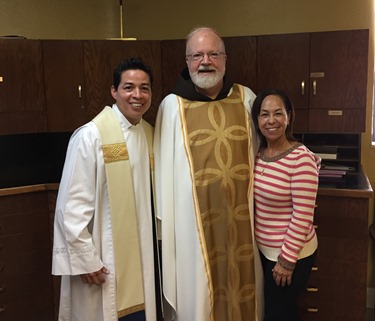
And, as we have been speaking in this Year of Mercy a lot about Holy Doors of Mercy, I wanted to share with you these pictures from the parish.

This is actually a glass door, but on the inside they’ve placed what is essentially a decal reproducing the Holy Door of St. Peter’s Basilica in Rome. I thought it was very cleverly done!
Until next week,
Cardinal Seán

